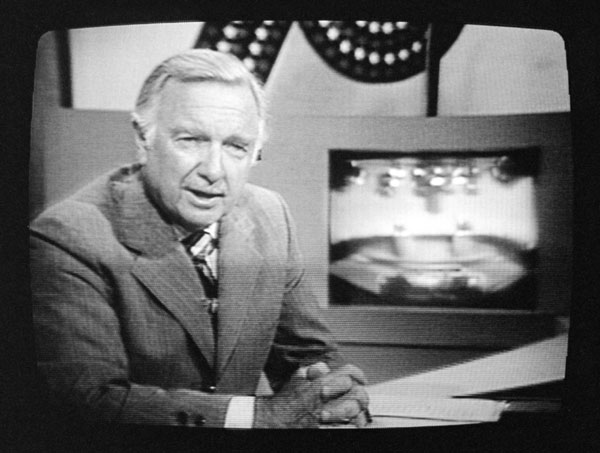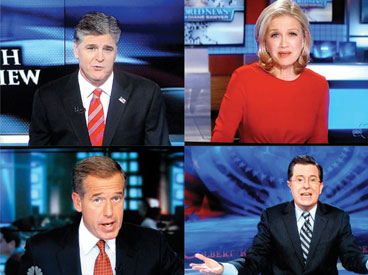
Impartiality became such a widely accepted ideal through the middle of the 20th century that even as there got to be more and more sources for news, with the rise of broadcast radio and television, people assumed that news, wherever it came from, was always as accurate and unbiased as possible. That’s why in the 1960s Walter Cronkite, the friendly uncle of all America, could close his nightly CBS Evening News broadcast by declaring, “And that’s the way it is.”
Of course, that wasn’t really quite the way it was. Cronkite’s show was less than half an hour of quick reports on one news team’s choice of important events. Throughout the midcentury of the conformist press, a lot didn’t get reported, or at least fully examined. In what is possibly the most extreme example of bias by omission, when the atomic bombs dropped on Hiroshima and Nagasaki, the government controlled all the reporting on the subject, and the official word was that no deadly radiation was released. Americans had little idea of the horror in those cities until a year later, when John Hersey, writing in The New Yorker magazine, uncovered the story no newspaper had gotten, with descriptions like the following: “hundreds and hundreds … were fleeing. … The eyebrows of some were burned off and skin hung from their faces and hands. … Some were vomiting as they walked. Many were naked or in shreds of clothing.”
This is but one example of the many ways news can be biased even when reporters try their damnedest not to insert opinion into a story. Gladstone identifies the types of non-political bias that she looks for:
• Commercial bias. The preference for new, exciting stories over less dramatic news.
• Bad news bias. Bad news sells more papers because we are drawn to stories that scare us.
• Status quo bias. The underlying assumption that the system works and things are mostly okay.
• Access bias. Reporters don’t want to alienate their sources, so they tend to tread lightly around issues that would be sensitive to them.
• Visual bias. The preference for stories with good pictures.
• Narrative bias. The preference for stories with a clear beginning, middle, and end.
• Fairness bias. Giving all sides of an issue equal weight even when some points of view may be just stupid or even crazy.
The mainstream media began to fracture in the 1960s, and some trace this to the day Walter Cronkite, “the most trusted man in America,” came out against the Vietnam War. Was it a newsman’s place to take sides? His stand helped bring an end to Lyndon Johnson’s presidency. Shorty thereafter, impartial newsgathering was joined by outright newsmaking when the staid Washington Post did the fearless investigative reporting that broke through the Watergate cover-up and ultimately brought down Richard Nixon.
But those changes were minor compared to the impact of the technological developments that followed. First there was the rise of cable TV, multiplying the number of outlets for news. Then there came the cultural earthquake of the Internet. In the past 15 years, as the Internet has become something almost every American relies on every day, newspapers have fallen into a struggle to survive, losing to the Web both the advertising dollars that are their life blood and the readers they exist to serve. They have had to lay off so many reporters that most of them simply can’t cover the news the way they used to. At the same time, the Web has become a democracy of instant newsgathering and reporting by absolutely anybody with access to a smartphone. There are now fewer trained professional journalists but far more amateur ones. In this blizzard of reporting, it’s become exponentially more difficult for the reader to separate what is accurate from what is whim, conjecture, or nonsense
The sheer numbers of amateur journalists—nowadays anyone in the presence of a newsworthy event is likely to tweet and share on Facebook what they see and hear—ensures that ordinary people will break a lot of news. Sometimes the news is real. An early example of this came in 2002, when Senator Trent Lott praised the era of segregation at a birthday party for his colleague Strom Thurmond. No one in the traditional press noticed; but a bunch of bloggers, including Joshua Micah Marshall of Talking Points Memo and Andrew Sullivan of The Dish, did. Their reporting of the incident ultimately led Lott to resign as Senate minority leader. Similarly the video of Mitt Romney making remarks about the “47 percent” during the 2012 presidential campaign was first uncovered by a pro-Obama opposition researcher who simply trawled the Internet for video that could embarrass Romney, and then news organization Mother Jones published it online. And it was a blogging website that revealed that the girlfriend of college football star Manti Te’o didn’t really exist, after the entire mainstream media had missed that story.
But the Web is full of rumors and fabrications, too, now that anybody can write and publish anything there. The myth of Barack Obama’s having been born in a foreign country and given a fabricated birth certificate was drummed up and kept alive by countless online conspiracy theorists in defiance of fully established truth, taking on a kind of zombie life long after it had been discredited. In 2012 much of the mainstream media reported that Google was buying a Wi-Fi provider named ICOA for $400 million; that turned out to be a complete online fabrication.
It can all get so confusing that even the government of the world’s biggest country can be fooled: On its website last year, the satirical newspaper The Onion reported North Korean leader Kim Jong Un had been voted the sexiest man on earth, and China’s People’s Daily Online, an organ of the ruling Communist party, earnestly passed along the news. In the words of Gladstone, “The reality that anyone with a cell phone can now presume to make, break, or fabricate the news has shaken our citadels of culture and journalism to the core.”
So today it can be harder than ever to know what to believe, who is telling it straight, and what is the product of terrible reporting, extreme bias, or even outright dishonesty. But just as everyone today can act as a journalist, everyone can act as a fact-checker, too, and the Web swarms just as thickly with people exposing bias and falsehood as it does with people creating it. Sites like politifact.com and factcheck.org and snopes.com exist solely to sniff out rumors and reveal the truth. If you’re a careful, critical reader, you can often find the truth very easily once your suspicions are aroused. (See “Only The Facts” for tips on how to separate truth from fiction.)
Our nation has always relied on a press that is free, considering it nothing less than a foundation of our democracy. But we have always paid the price for that freedom, allowing voices that are reckless or bigoted or plain wrong to be heard too. Finding the news you can trust has always been every citizen’s job. It has just gotten more complicated. And above all, remember that media is biased because people are biased. Every one of us is biased; we all see the world through the lenses of our personal beliefs and predispositions, and we all like to hear news in a way that supports our own preexisting views, reinforcing our own biases that we may not even know exist. As Gladstone puts it, “News consumers say they want objectivity, but they choose news outlets that reflect their views.” That’s just human nature.
Become a Saturday Evening Post member and enjoy unlimited access. Subscribe now



